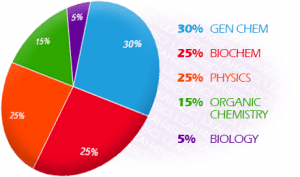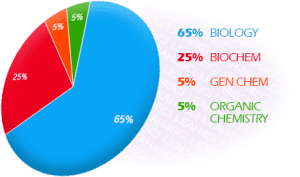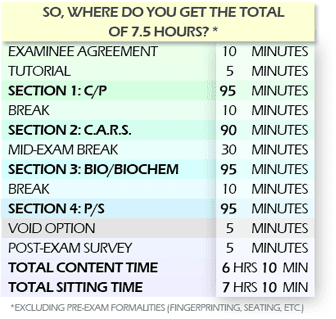Stumbled onto the Ultimate MCAT Prep Guide? Click to Start at the Beginning.
MCAT stands for Medical College Admissions Test.
The MCAT is like the SAT for medical school.
In addition to all of your college courses, research, volunteering, clinical experience, and other extra-curricular activities, you will need a strong MCAT score as part of your medical school application.
Along with your GPA, this score will help the admissions committee decide whether or not to review your application and potentially offer you an interview.

Before we dive deeper into this very intimidating monster called the MCAT, stop and watch this video for a quick overview of the MCAT sections, subjects, timing, and more.
The MCAT is approximately 7.5 hours long, excluding pre-exam formalities (fingerprinting, seating, etc.).
It is comprised of four sections testing eight proficiencies.
ALL questions are multiple choice, whether passage-based or discrete (non-passage based stand alone questions).
The eight proficiencies tested on the MCAT include:
- Physics
- General Chemistry
- Organic Chemistry
- Biochemistry
- Biology
- Psychology
- Sociology
- Verbal Reasoning (CARS)

Later in this chapter we will discuss which courses are required and what to do if you haven’t taken a specific college course related to that subject. But first, make sure to jot these down in your Companion Workbook.
The exam itself is as follows:

Section 1: Chemical and Physical Foundations of Biological Systems
We’ll call it the Chem/Phys or C/P section.
This section contains a total of 59 questions within 95 minutes (one hour and thirty-five minutes).
This includes 15 discrete questions and 10 passages each containing 4-7 questions.
This section will test, on average, with the following breakdown:
- 30% General Chemistry
- 25% Biochemistry
- 25% Physics
- 15% Organic Chemistry
- 5% Biology
We will discuss what courses you need in order to master this section later in this chapter. See What College Courses Are Required for The MCAT?

Section 2: Critical Analysis and Reasoning Skills aka CARS
The CARS section contains a total of 53 questions within 90 minutes (one hour and thirty minutes).
This includes 0 discrete questions and 9 passages each containing 4-7 questions.
This section will test, on average, with the  following breakdown:
following breakdown:
- 50% Humanities
- 50% Social Sciences
Since this is a “verbal reasoning” section, you do not require any outside knowledge. Instead, you’ll need practice and experience in answering passage-based questions.
 Section 3: Biological and Biochemical Foundations of Living Systems
Section 3: Biological and Biochemical Foundations of Living Systems
We’ll refer to this section as the Bio/bchem or B/B section.
This section contains a total of 59 questions within 95 minutes (one hour and thirty-five minutes).
This includes 15 discrete questions and 10 passages each containing 4-7 questions.
This section will test, on average, with the following breakdown:
- 65% Biology
- 25% Biochemistry
- 5% General Chemistry
- 5% Organic Chemistry
We will discuss what courses you need in order to master this section later in this chapter. See What College Courses Are Required for The MCAT?
 Section 4: Psychological, Social and Biological Foundations of Behavior
Section 4: Psychological, Social and Biological Foundations of Behavior
We’ll call this the Psych/Soc or P/S section.
This section contains a total of 59 questions within 95 minutes (one hour and thirty-five minutes).
This includes 15 discrete questions and 10 passages each containing 4-7 questions.
This section will test, on average, with the following breakdown:
- 65% Psychology
- 30% Sociology
- 5% Biology
This section tests psychological and sociological underpinnings in health and medicine, such as health disparities and behavioral/social influences on health. It’s not surprising that there is biology in this section!
For an in-depth look & more specific breakdowns on what’s covered in the MCAT, see the AAMC’s 100+ page guide: “What’s on the MCAT Exam”
Before the exam you will have ten minutes to complete the examinee agreement.
An additional ten minutes is given to read through a tutorial on how to take the exam.
I, personally, recommend using this time to collect your thoughts and calm down.
There is a total of three breaks:
- 10 minute break after Chem/Phys
- 30 minute lunch break after CARS
- 10 minute break after Bio/Biochem
You’re nearly there!
You’ll have five minutes after the exam to decide whether or not to void your exam.
An additional five minutes to complete a post-exam survey.
All this, plus the actual testing time, brings you to a total of 7.5 hours.
Important Minutia About the MCAT
These may seem like minor details but they can have a major impact on your performance.
- You are not allowed to use a calculator, yet you will be required to carry out calculations from buffers and titrations to focal point distance and more. Before you dive into the sciences, you MUST get comfortable doing math without a calculator. Not sure you can? Study my MCAT Math without A Calculator Video Series.
- You cannot leave the testing center for lunch; you must bring food and drinks to store in your locker.
- You are allowed to bring sealed/unopened earplugs during the MCAT. Bring the soft foam ear plugs (such as these: https://amzn.to/2l1rfu4) to avoid getting distracted as students around you are moving about, getting up, sitting down, or talking to the proctor.
You’ll be provided with giant headphones that are of poor quality… Each testing site may vary so it would be wise to call and get the specifics straight from them. - Temperature fluctuations can really mess with your concentration. Wear simple comfortable layers to the testing center, such as a tank top under t-shirt under a hoodie, that you can store in your locker if necessary. Shed as required.
Now that you know about the eight proficiencies tested on the MCAT you're likely wondering, “How do my college classes relate to MCAT prep?”
To reiterate, the eight disciplines covered are:
- Physics
- General Chemistry
- Organic chemistry
- Biochemistry
- Biology
- Psychology
- Sociology
Some classes might teach you just enough for the MCAT, while other professors may overwhelm you with such nauseating detail that it will actually hurt more than help you if taken solely for MCAT prep.
Don't forget, you take these classes over several years. It's natural to forget.
Think about it, what are the chances you’ll retain all the concepts and formulas you learned in general chemistry or pathways in biology when taken years prior to your MCAT?
The point is, you want to treat this outline as a list of subjects you will have to RELEARN and RE-STUDY to prepare for the MCAT.
The MCAT is about relearning, not relying on what you already know…
The good news is, material well-understood is material quickly relearned!
Even if you did well in the course, but especially if you did poorly or forgot a lot of the material, plan on investing extra time in studying this again.
The same goes for classes not yet taken.
Every situation is unique, and it’s very possible that– for one reason or another– you are not able to take all of the prerequisite courses before sitting for your MCAT. You might have to self-study a subject or two!
If you think this might be you, watch this video where I discuss how much study time to add for MCAT related science courses not-yet-taken.


Keep track of the courses you've taken or plan to take in your Companion Workbook. Later you'll add notes for how much extra study time to allot based on courses not yet taken and self teach subjects.

Physics is NOT an easy course to learn on your own. So while the MCAT is not very physics heavy, it is certainly important to take physics before starting MCAT prep.
I recommend college level Physics 1 and 2, algebra-based rather than calculus-based (overkill for the MCAT).
AP Physics barely suffices and is not recommended as your only pre-med physics background.
Again, this is a foundational class that is a MUST before tackling your MCAT.
College level General Chemistry 1 and 2 are not only recommended, they are required prerequisites for upper level courses like Organic Chemistry and Biochemistry. General chemistry is a must for the MCAT.
This is the college course that scares a lot of premeds and is not as well represented on the MCAT.
However, it does show up disguised in gen chem concepts and Biochemistry pathways.
Organic Chemistry 1 is absolutely necessary, not only for med school, but for a solid MCAT foundation.
Organic Chemistry 2 is recommended but since much of it is NOT covered on the MCAT (Hell-Volhard-Zelinsky step by step halogenation mechanism? Not quite), it’s okay to self teach.
Note: some medical schools are dropping the Orgo 2 requirement in favor of biochemistry. Be sure to research your dream med school’s required courses.
This course is the cause of much controversy:
On the one hand, it is advisable to take an Introduction to Biochemistry course for the MCAT.
On the other hand, this subject is so broad that chances are, a single biochemistry course will NOT cover all you need or give you the required emphasis on key topics for the MCAT.
In fact, my MCAT Biochem Bootcamp covers information that I personally learned in both my Biochem 1 AND Biochem 2 undergrad courses. Furthermore, some of the MCAT biochemistry topics are skipped over by most undergrad biochemistry professors.
Don’t get me wrong, this course is VERY important; it helps you tie many sciences together. Plus many medical schools now require biochem as a prerequisite.
What does this mean for you? If you don’t have time to take this course BEFORE your MCAT, that’s okay. Try to take it after or self-teach in preparation for medical school.
Step 2 discusses extra time required to self-teach.
This one is all over the place.
The AAMC recommends an Intro to Bio course.
Having completed my BS in Bio (and my BA in chem), I can’t even begin to pinpoint which classes will teach you everything for the MCAT.
For example, here are just SOME of the courses I took in my undergraduate curriculum that covered MCAT biology related topics: Basic Biology, Cell Biology, Molecular Biology, Genetics, Evolution, Physiology, Anatomy, Genetics, Microbiology, Micro Research; Botany and Zoology didn’t really help.
I learned even more in the classes for my Health & Nutrition minor.
If you look back at the subject breakdown per test section, you’ll notice that biology has the highest percentage. It shows up in three of the four MCAT test sections! That’s the greatest representation compared to the other sciences.
Am I suggesting you take all the bio major classes?
Not unless you want a bio degree!
Instead, I recommend taking at least two or three really good biology classes such as Cellular/Molecular Biology, Microbiology, Genetics and Physiology.
Plan your classes according to your dream med school requirements. Then, be prepared to invest A LOT of time learning the remaining MCAT-specific bio following the AAMC outline.
These two subjects are trickier to nail down to a specific class. Ask any student who’s taken an Introduction to Psychology or Sociology course to tell you what they covered. The answers will be so varied that it will be tough to determine which specific classes will help you prepare.
Taking a psychology or sociology class will certainly help.
The class discussions and readings will prepare you for how to think on this section. But when it comes to MCAT prep, even the companies that offer MCAT prep don’t cover it all.
In fact, in Tyler’s post MCAT interview, he discussed using High School material to help him earn a perfect score in this section.
In other words, it’s okay to have taken ANY or NO classes to prepare for this section.
This isn’t the type of section that you “study for” as much as practice and prepare. Taking courses that are heavy in literature, reading, and analysis will help improve your critical thinking ability. These will help you develop strategic analysis skills critical for the MCAT.
See Step 7 for more details.
The MCAT is only administered during specific times of the year. Back in the day it was given only three times yearly. Now the MCAT is offered in January, and then multiple times per month April through September. See this years dates in this article

Allopathic medical school (MD) applications are submitted through AMCAS (American Medical College Application Service).
Osteopathic medical school (DO) applications are submitted through AACOMAS (American Association of Colleges of Osteopathic Medicine Application Service).
This accounts for nearly all of the medical schools in the United States and Canada.
A small number of schools do NOT go through the AMCAS. For example, Texas residents should check out TMDSAS (Texas Medical and Dental Schools Application Services) for specifics on applications and deadlines.
Both AMCAS and AACOMAS open the registration cycle in May. This allows you start inputting all your information, including grades, activities, essays, and more.
Not sure how AAMC scheduling, registration zones, fees, and more, work? Check out this video where I explain it all
In June you can start submitting your application for verification and then to your target medical schools.
To maximize your chances of acceptance, aim to have your application submitted as early as possible. June is ideal, July is slightly less ideal, and August is starting to push it. We will discuss this more in the following section below.
Timing is everything. When you apply to medical school is nearly as important as your application’s contents. Applications for most U.S. medical schools are on a rolling admissions basis. Canadian schools are different and will be discussed below.
Rolling admissions is just that: when the gates (applications) open, the admissions start rolling. If you apply early, your application is looked at sooner, and you are more likely to get an interview. As the interviews take place, seats start filling up.
The later you apply, the less likely you are to be considered, interviewed, and accepted.
An average student application submitted early may result in an acceptance, whereas that same application submitted later in the cycle may result in a wait-list or even rejection.
Knowing that an early application is ideal, when should you take your MCAT?
This is the million dollar question. While there are good reasons for testing at certain times of the year, you ultimately have to evaluate your personal situation and figure out what is best FOR YOU. The information below is simply a guide to help you make a more informed decision.
The entire application cycle takes over one year. You can’t take the MCAT in 2019 and expect to start in 2019.
For example:
If you test in April 2019 and apply in June 2019, you’ll hope to get secondary applications in Summer 2019. Your interviews should follow in Fall 2019 or Winter 2019 for acceptance into the Fall 2020 starting class.
–Primary applications let the school know you want to attend; secondaries are when the school shows interest in the student and wants more details. (Some schools will send secondaries to all applicants.)–
This means you have to plan your test date well before you start studying.
Schools outside the US/Canada will have completely different cycles. For example, some Caribbean schools have a Fall and Winter starting class.
I recommend reaching out to the individual school for details, deadlines, and specifics.
Since the testing/application process takes over a year, you have to start planning well in advance. Will you take a gap year after completing undergraduate studies?
Here’s what to expect in each scenario:
Many ‘traditional’ premeds avoid the gap year. This means they schedule their exam and application junior year to ensure acceptance prior to graduation.
If you’re NOT taking a gap year, then you're studying for the MCAT Fall and Spring semester of your junior year. This allows you time to work on applications and interviews in your Senior year.
Graduation in May/June is immediately followed by medical school in August/September.
Traditional Students: If you take the MCAT during senior year you wind up with a full year of applications and interviews between when you test and when you start medical school. This ‘gap’ between undergrad and medical school is called a Gap year.
If you begin MCAT prep AFTER graduation to test in the Winter/Spring, you wind up with 2 ‘gap years’.
- First year to study and test.
- Second year for applications and interviews.
If you want to take a gap year: use your year off to improve your application by doing research or volunteering and getting lots of clinical experience.
Non-Traditional Students
If you’re already out of school try to follow this plan: Take the MCAT in early Spring one year and expect to start medical school in the Fall a year and a half later.
If you want to take a gap year: use your year off to improve your application quality by doing research or volunteering, and apply to be accepted the following year.
For example: If you plan to start MCAT prep in September 2019. Study through the Fall and winter and aim to test in January or April 2020. This allows you to work on and submit your application in June 2020 to start medical school Fall 2020.
 Once you’ve chosen your testing year, you need to choose an MCAT test date. A lot of thought and planning goes into this choice.
Once you’ve chosen your testing year, you need to choose an MCAT test date. A lot of thought and planning goes into this choice.
Make sure to mark down important dates/timelines in your Companion Workbook.
My first Commanding Office (US Navy) made us recite the ‘7 P's of success' every morning.
Prior Planning and Preparation Prevents Piss Poor Performance
For most students, a lack of proper planning is what results in a delayed test day, delayed application and ultimately, a delayed start in medical school.
Don’t let this happen to you. Remember that it takes about a month after testing to receive your MCAT scores.
An ideal Study Prep / Testing Timeline looks like this:
- Take the MCAT in April
- Start working on your application essays after your exam
- Start inputting and perfecting your application throughout May as you await your MCAT scores
- When applications open in June, hit submit soon as you can and start preparing for your secondaries.
A word of caution before we dive further into the fun that is study planning:
DO NOT BECOME OBSESSED with the plan.
Your plan is just the means to an end. Many students fall victim to obsessive planning to the point where it can take months to devise the perfect schedule…
with little time to execute!
Read about how to make a plan, figure out what works for you, and then DIVE RIGHT IN! The most important part of MCAT prep is the PREP, not the planning.
You can plan to follow my ideal outline above, but my experience as an MCAT tutor has continuously taught me that emergencies never check the calendar. Life doesn’t always happen the way you want or expect it to.
Unexpected things happen to get you off track. They can range from
- Illness,
- Personal/emotional issues,
- Being overwhelmed at work or school,
- Unexpected life changes/events,
- Not able to study as much as you planned,
- Needing more time to study than you allowed for in your initial plan.
For instance,
I had a student who was scheduled to test in January 2016 to meet a February improved score submission deadline. Everything was going as planned until a blizzard knocked most of the East Coast out of commission. Her MCAT testing center closed, forcing her to test in February (this is not a standard testing month, but was added due to the special circumstance).
Needless to say, she missed her deadline and had to revise her long term plans.
You’ve made sacrifices. You’ve invested countless hours and financial resources to get to this point in fulfilling your dream of becoming a Doctor!
You’ve probably missed family events to study for exams. Pulled all-nighters to be prepared for lecture and quizzes. Maybe you’ve even paid for tutoring to get you through organic chemistry!
Bottom line: This is one of the biggest steps towards achieving your dream.
Don’t leave it to the last minute.
If a student comes to me in the Summer/Fall with the intention of testing the following year, I have them test as early as possible. If at all possible, aim for January!
Why?
If you planned to test in January:
What If life happens and you’re not ready to test on your target date? You have 2+ months of buffer to still complete your exam in April and application by june. Two months is just enough time to fix last-minute studying issues or score plateaus.
If you planned to test in April:
You realize are not ready, what date will you postpone to?
- Pushing till May doesn’t give you much more study time.
- If you push to June or July you’re starting to mess with the ‘early' timeline.
Of course, if you’re just starting your prep and it’s already in the middle of MCAT season, you have to choose between
- testing sooner with a potentially lower score or
- postponing your exam but risking waitlist or rejection (due to late application)!
If you miss the April/May exams, it’s not the end of the world!
At least a quarter, if not a third of the applications are already submitted by the first month. But there's still an entire MCAT season.
Why am I harping on the early exam/application?
The later you apply, the lower your chances of getting accepted. If you submit your application when other students already have interview requests, seats will start disappearing while you work on secondaries and schedule interviews.
You planned to test in June:
Testing in June means a July score. This isn’t bad–you’re not too behind.
You planned to test in August/September:
Keep in mind that testing later than July may hurt your chances: admission committees may already have interviews and acceptances lined up.
I don’t recommend aiming to test in August or September unless you’re
- reapplying with a stronger score,
- applying to a program with later deadlines,
- already have an “in,” such as a bridge post-pac to med school program, B.A.M.D. or similar,
- You really Really REALLY had no other choice.
Of course, if you’re testing late in the year because you’re applying the following year, that’s great! This allows you to get your exam over with as you relax for half a year until the next cycle of applications opens for submission.
For even more on choosing a test date, read: The Right Time to Take the MCAT.
Osteopathic medicine is a newer form of practicing medicine. It was introduced about 130 years ago. As with anything new and less understood, it was looked down upon years ago.
But for some reason, today, many students think, “If I didn’t get into an MD program, then I’ll apply to DO program.”
That should not be the case. The stigma has all but disappeared and DO schools produce great doctors.
Furthermore, AACOMAS has updated their Repeat Coursework Policy; they no longer offer grade replacement and therefore have made DO applications even more competitive. Click to read about it on the AACOMAS Website.
In fact, before I found my passion for teaching, I was a premed student with my heart set on USUHS (military medical school) or NYCOM New York College of Osteopathic Medicine an osteopathic school in Long Island, N.Y. I only ranked USUHS over DO because it is a military medical school.
Allopathic medical schools (that participate in the AMCAS) have deadlines that range from August through December. Osteopathic medical school deadlines range from September through March. Yes, they may have slightly later application deadlines, but the principles are still the same: Apply earlier, rather than later.
Most Canadian medical schools and a VERY small number of American schools do not operate on a rolling admissions basis. Instead, they have a hard application deadline.
If you are interested in applying to any of these schools, be aware of their deadlines and schedule your MCAT date accordingly:
You should aim to take your MCAT no later than five weeks prior to the earliest deadline. This gives just enough time for scores to be released and submitted with your completed application.
Of course, rolling admissions or not, I strongly advise testing way earlier than five weeks before your absolute deadline. Remember: emergencies and life events do not consult the calendar.
Now that you understand what to expect from the exam and when to take your MCAT, let’s talking about setting specific yet realistic goals. This and more in Step 2.
– -> Take me to Step 2
Click to return to the Ultimate MCAT Prep Guide home page
And if you haven't already…
Be sure to download the Companion Workbook to help you keep track of what you learned in this chapter. Focus on tactics, steps, specifics, and of course your biggest takeaway from this chapter.

























